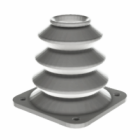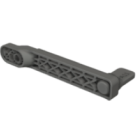Recycled 3D printing filament
As sustainability becomes a core concern in manufacturing, additive technologies are also adapting. One of the most meaningful shifts is the rise of recycled 3D printing filament — materials made from post-industrial or post-consumer plastic waste, reprocessed for use in extrusion-based 3D printing. These filaments not only reduce the environmental footprint of production but also open the door to a more circular, resource-efficient form of fabrication.
Can 3D printers use recycled filament reliably?
Yes — most FDM and FFF 3D printers can use filament made from recycled plastic, as long as it meets the same diameter tolerance, melt flow consistency, and moisture content standards as virgin material. The key is not whether recycled plastic can be used, but how well it’s processed.
Recycled filament is typically made from shredded and pelletized plastic waste, such as PET bottles, PLA support material, or industrial offcuts. This material is then extruded into filament spools under controlled conditions. Depending on the manufacturer, the recycled content can range from partial blends to 100% reclaimed material.
The performance of these filaments depends on the quality of the recycling process. Impurities, inconsistent melt flow, or moisture retention can lead to extrusion issues, poor layer bonding, or dimensional inaccuracies. However, with modern compounding and filtration techniques, high-quality recycled filaments are increasingly reliable and suitable for a growing range of functional prints.
Types of eco-friendly and recycled 3D printing filaments
Many filaments now marketed as eco-friendly 3D printer filaments fall into one of two categories: fully recycled, or bio-based and biodegradable. In this context, recycled refers to materials recovered from waste streams, while bio-based refers to filaments derived from renewable plant sources, like corn starch (as in PLA).
Among recycled filaments, common options include:
- rPLA – recycled polylactic acid, often recovered from failed prints or support structures,
- rPETG / rPET – derived from consumer plastic bottles or packaging materials,
- rABS – more challenging to recycle cleanly but used in closed-loop systems,
- composite blends – mixes of recycled polymer and additives like wood fiber or carbon powder.
Some filament suppliers now offer full transparency on the source of their raw material, adding credibility to claims of sustainability and ensuring better batch-to-batch consistency.
Applications and limitations of recycled 3D printer filament
Eco friendly 3D printing materials made from recycled sources are ideal for:
- rapid prototyping with low environmental impact,
- architectural models and visual parts,
- educational and outreach projects,
- internal jigs and fixtures where high-load performance isn’t critical.
However, recycled filaments generally aren’t recommended for high-precision or high-performance mechanical components, especially if the recycled content is not tightly quality-controlled. Print quality can vary depending on moisture exposure, pellet uniformity, and pigment content, all of which affect flow and bonding. For more demanding applications, hybrid materials — combining recycled polymer with reinforcing fillers — offer a middle ground between sustainability and performance.
Can you recycle failed 3D prints into new filaments?
Aside from using recycled material, many users are also exploring recycling 3D prints themselves — grinding down failed prints or support waste to re-extrude new filament. While this concept is technically feasible, it requires specialized equipment like filament extruders, shredders, and dryers, and the quality of the resulting filament is highly dependent on process control.
As of now, distributed recycling is mostly used by makerspaces, research labs, or institutions with sustainability mandates. Commercial-scale recycled filament is generally the more reliable route for everyday users seeking eco friendly 3D filament without investing in infrastructure.
Summary: is recycled 3D printing filament a viable material option?
The use of recycled plastic for 3D printing is growing rapidly — not as a compromise, but as a conscious design and production choice. Recycled 3D printing filament offers a more responsible way to fabricate, especially in non-critical applications where aesthetics, concept validation, or volume prototyping is the primary goal. While recycled filaments do present some technical limitations, advancements in sorting, filtering, and extrusion technology are closing the gap between sustainable and high-performing materials. As the industry evolves, eco friendly 3D printing will become less of a niche and more of a baseline expectation for responsible manufacturing.
Explore also
- Polymers in 3D printing
- 3D printing of metals
- Biocompatible materials for 3D printing
- Raw materials for 3D printing
- Composites 3D printing
- 3D printing flexible
- Filament types for 3D printing
Related categories
 Austria
Austria  Bosnia and Herzegovina
Bosnia and Herzegovina  Bulgaria
Bulgaria  Croatia
Croatia  Czech Republic
Czech Republic  Denmark
Denmark  Estonia
Estonia  Finland
Finland  France
France  Germany
Germany  Greece
Greece  Hungary
Hungary  Ireland
Ireland  Italy
Italy  Latvia
Latvia  Lithuania
Lithuania  Poland
Poland  Portugal
Portugal  Romania
Romania  Slovakia
Slovakia  Slovenia
Slovenia  Spain
Spain  Sweden
Sweden  Switzerland
Switzerland  United Kingdom
United Kingdom  Ukraine
Ukraine  China
China  Hong Kong
Hong Kong  India
India  Israel
Israel  Japan
Japan  Malaysia
Malaysia  Philippines
Philippines  Saudi Arabia
Saudi Arabia  South Korea
South Korea  Taiwan
Taiwan  Thailand
Thailand  Turkey
Turkey  United Arab Emirates
United Arab Emirates  Egypt
Egypt  South Africa
South Africa  Tunisia
Tunisia  Canada
Canada  Mexico
Mexico  United States
United States  Brasil
Brasil  Colombia
Colombia  Australia
Australia  New Zealand
New Zealand 












